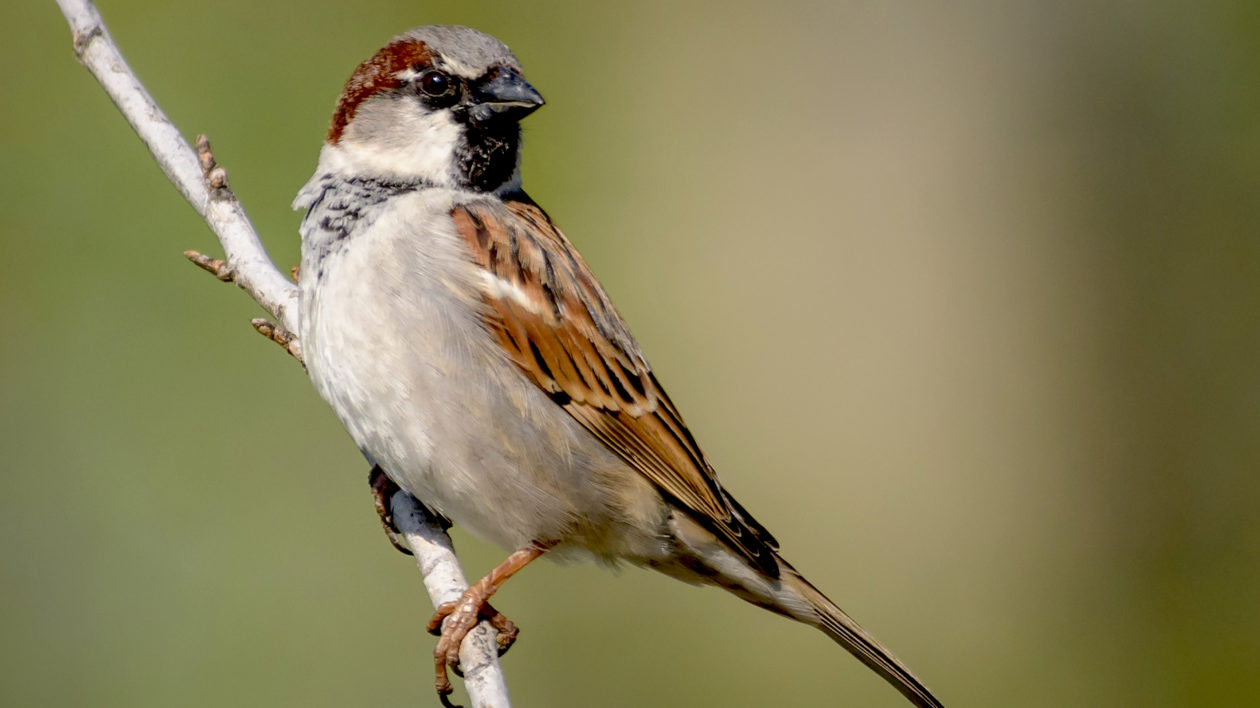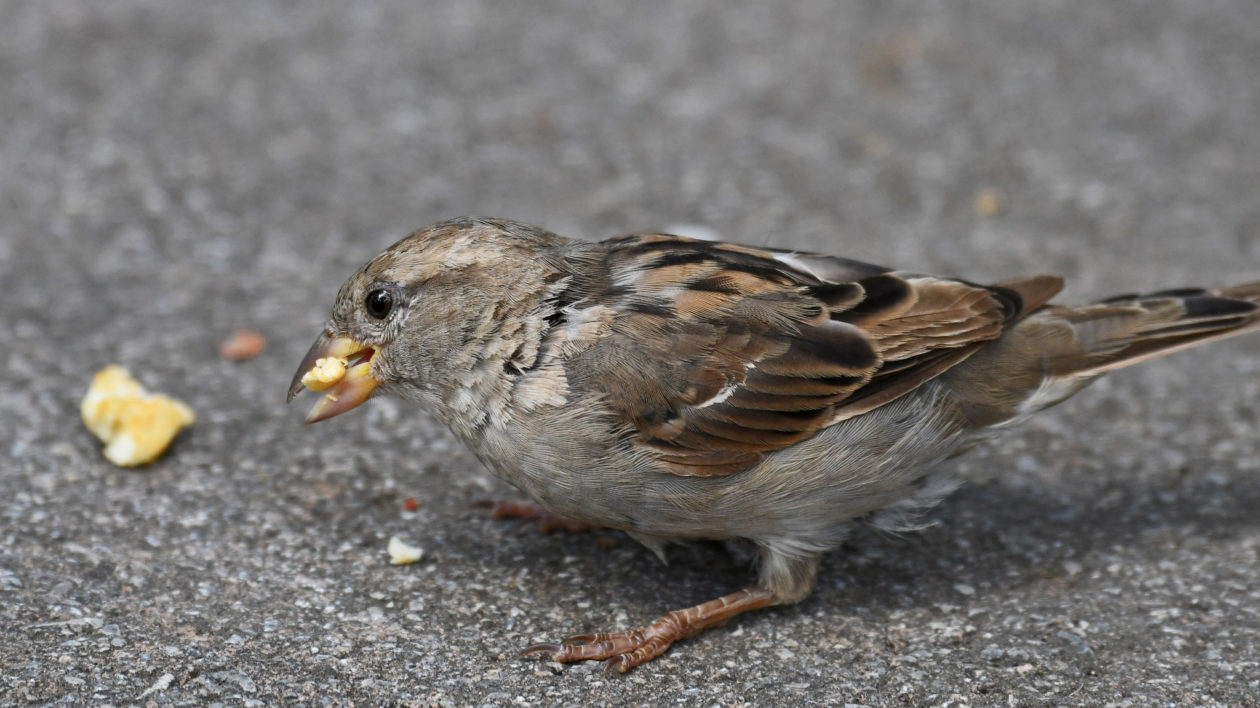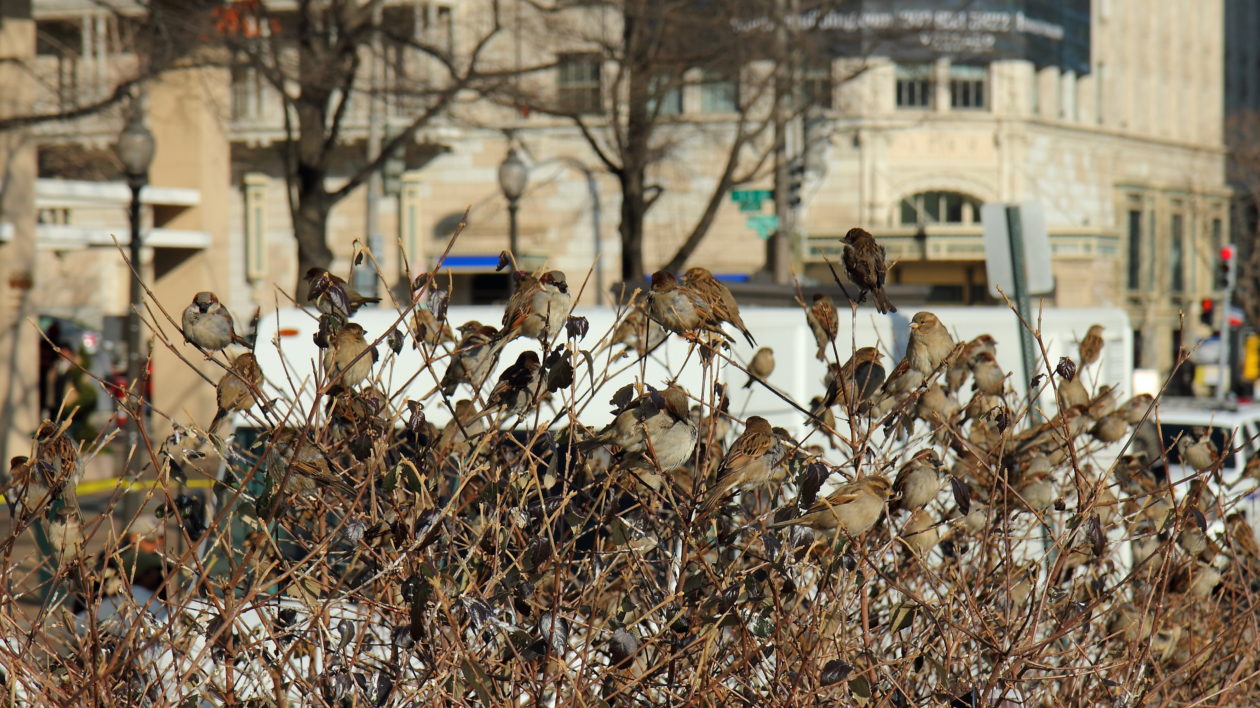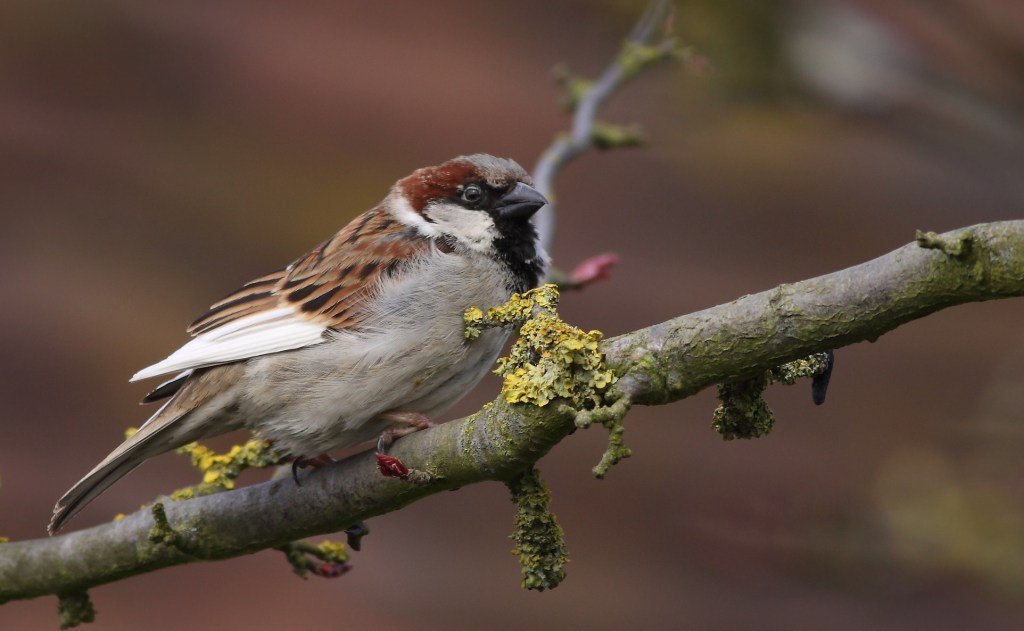I look out my window, and they’re everywhere: hundreds of house sparrows flit around our shrubs, hop around the yard, and steal food from our backyard chickens.
At this time of year, the males puff up and display, making them appear like much larger birds. They cheep incessantly, often drowning out other birdsong.
Given their constant presence, it seems odd to be writing this: House sparrow populations have been declining worldwide, including in their native range.
House sparrows are often considered one of the most adaptable birds, capable of thriving amongst our farms, suburbs and cities. The real story of their spread and decline is a bit more complex, and may have implications for urban conservation.
The Sparrow Fad
The house sparrow (Passer domesticus) is native to Eurasia, but beginning in the mid-1800s, it spread around the globe. Largely due to intentional releases by humans, house sparrows are now found on every continent except Antarctica, as well as many islands. It is the most widespread wild bird on earth.
As with many aspects of conservation history, many of the details of sparrow introductions are poorly documented. The first introduction to North America was to New York City in 1851 or 1852, although the 8 pairs released seemed to fare poorly. However, this set off a wave of introductions throughout the United States.
For a time, some sources refer to a “sparrow fad,” with private individuals breeding birds, and others catching them and releasing them into new areas. Nest boxes were installed in cities to increase sparrow populations. Ornithologists and others raised concerns over the merits of house sparrows, but their arguments proved futile against sparrow enthusiasts releasing cages full of birds.
The reason for many of these reasons was for pest control. For instance, their 1868 introduction to Philadelphia was apparently an effort to control inchworms. As with so many such pest control efforts, the cure proved worse than the disease. They thrive on a variety of foods, including spilled grain and even garbage.
The house sparrow is also an aggressive little bird. It nests in cavities, and pushed out native species like Eastern bluebirds. Backyard birders who erect birdhouses have undoubtedly noticed house sparrows bullying wrens and other native species.
Public sentiment turned quickly against the house sparrow. By the 1880s, just three decades after the first introduction, several U.S. cities paid bounties for the birds. But by then the bird was firmly established – and spreading.

Recent research published in the Proceedings of the Royal Society B found that house sparrows underwent genetic changes, including modified skull development and a gene that helps create the enzyme amylase that helps break down starch. The researchers hypothesized that these changes helped sparrows adapt to human settlements dominated by agricultural fields and livestock. The sparrows, according to the research, diverged from other Old World sparrows around 11,000 years ago, just as agriculture was taking hold in the Middle East.
The house sparrow appears to be a clear winner in the Anthropocene: an adaptable bird capable of thriving equally well on cities and in farms.
But over the past few decades, ornithologists have noted a new trend: house sparrows are in widespread decline. According to the Cornell Lab of Ornithology, house sparrow numbers in North America have declined by 84 percent since 1966. In Philadelphia, the city where the sparrows were introduced to control inchworms, the birds have largely disappeared.
Many birders view this as a good-news story. After all, house sparrows compete with native species and are generally viewed as a pest. However, the bird is experiencing similar declines in many parts of its native habitat, including the United Kingdom and Western Europe.
In England, house sparrow populations have declined by half. The species is listed by the Royal Society for the Protection of Birds as a species of high conservation concern. While the United Kingdom population has recently stabilized, the bird remains of concern to conservationists. European countries now recognize a World Sparrow Day to raise awareness of the plight of this once-abundant species.
What happened?

Sparrow Falling
Theories abound as to why house sparrows have declined. The answer likely lies in a combination of factors, all tied to rapid changes in both cities and farms. House sparrows may be highly adaptable, but that doesn’t mean they can thrive with every modification humans make to the environment.
The first house sparrow decline was actually reported in the 1920s, when automobiles began widely replacing horses. Sparrows feasted on the huge amount of spilled grain found in cities. When that food source was removed, sparrow populations decreased.
The Royal Society for the Protection of Birds and others note that changing agricultural practices likely play a significant role in the current sparrow decline. Once, farms were diverse, with crop fields and livestock barns scattered across the landscape. New, clean, intensified monocultures result in less spilled grain, and less cover around fields. In many parts of the world, other birds associated with farmland are also in decline.
Livestock is more frequently raised in confined operations, sometimes even indoors. All this results in fewer opportunities to feed on grain.
Similarly, city sanitary practices have improved, which may make finding meals more difficult for sparrows.
Research published in the journal Frontiers in Ecology and Evolution found that a combination of poor diet and air pollution induced physical stress on house sparrows, leading to reduced reproductive success.
The widely reported global insect decline may also be a significant factor. Many think of house sparrows as vegetarians, gobbling bird seed and grains. But, as with many birds, they rely on protein-rich insects to feed their young.

Implications for Urban Conservation
There are still 540 million house sparrows flying around the planet, so this bird is not in danger of going extinct. It’s still abundant in many places – including my neighborhood, where a mix of native vegetation, bird feeders and backyard chicken coops provide the diversity of habitat and food sources that enables these birds to thrive.
So why is the house sparrow decline important?
In part, it shows how little we understand urban ecology. Even conservationists often assume that common, adaptable species will be able to adapt to any change. That’s clearly not the case.
All ecosystems change, but human environments often change rapidly. If we’re thinking about protecting biodiversity in cities – and in a world that will have 9 billion people, we have to – we have to think about how changes impact wildlife. Just as modification to a tropical forest affects wildlife, so too do changes in farming practices, changes in city design, even changes in bird feeding habits.
I wouldn’t miss the house sparrow from my neighborhood. It’s an invasive species that competes with native birds. But globally, the sparrow’s decline is a story we should heed, as it may help us better understand how to coexist with nature in the Anthropocene.




Hundreds of sparrows around
In my area I have noticed a surge in the common house finch and a severe decline in ‘English’ sparrows. They compete, the finch may be winning.
The Nature Conservancy has just lost my support. How can you defend not managing such an invasive, destructive species that has decimated populations of native birds?
Hi EZ Smith,
The article was reporting on an interesting decline. There’s no advocacy of letting house sparrows run rampant.
Matt Miller
This article has little practical value and doesn’t even try to address the topic. What a waste of my time.
House sparrows dissapearing is alarming because they are so tough and adaptable. I haven’t seen any real sparrows for a good while. Haven’t heard a vesper or song sparrow sing in years. Honey bees are gone from my corner of pgh. Too. Seems like pesticides most likely and people afraid of a few bugs in their houses.
Their population has declined in western Europe too, specially in France where I am living. But I think there is an important thing that you did not mention. While the population of house sparrows is severely declining, the population of pigeons has increased strangely. You will find them almost everywhere in big cities. Can the increase in the population of pigeons be a reason for the disappearance of sparrows? Or is this the result of it?
The “Anthropocene” is not a scientifically accepted term within the field of geology, even though the concept has become very popular within environmental discussions. It’s best to avoid using such terms–or at least acknowledge that they are not scientifically supported–until and unless they become scientifically supported.
Mr Matthew sir I havent seen any sparrows for months and it is now July where have all the sparrows gone
Hello, could you please explain to me where are all of the House Sparrows have gone. They are usually nesting at this time.
I live in Southend on Sea Essex and cannot believe I cannot see any small Birds at all?
Thank you
Bernie
I have had sparrows feeding from my feed tables until the end of July, Suddenly they have disappeared
could you please tell me why, As there were dozens around nesting in house roofs and feeding young.
Kind Regards Peter Harrison.
Interesting reading !
I have been worried for some time about the disappearance of the common sparrow here in rural Brittany. Delighted, therefore, to see ( I think ) two sparrows in our garden. It may be aggressive and sometimes rather a pest but can we really tolerate the disappearance of any species?
My Brittany bird chart gives: “moineau friquet and moineau domestique”.
Which-is-which ? – in English, please !
David Byron. Pluvigner. Morbihan Brittany. Fr.
Thank you Matthew for your article.
I live 25 kilometres Southeast of Melbourne, Victoria, Australia.
I first noticed a rapid decline in the numbers of House Sparrow in my area in the mid 1990’s. In the early 90’s, it was rare to go anywhere in my home state without seeing flocks of hundreds of sparrows. The large bush land areas, State and National parks was the exception, they were still in the parks in small numbers only around picnic areas.
By 2005 it was rare to see more than a few birds anywhere. By approximately 2010 they were all but extinct in most of the state of Victoria. I haven’t seen a sparrow in my area in a decade.
In the semi-arid grain belt in the northwest of the state, they still persisted in small flocks of 20-50 predominantly around farm houses.
The speed at which the species has disappeared astounded me.
I have seen a noticeable decline in other introduced species, the Thrush and the Indian Minor.
I initially thought it must have been cause by a disease.
I also speculated that there may have been a connection between decline in introduced bird populations and the release of Calicivirus in Australia to eradicate rabbits.
That is probably unlikely if the decline is world.
About a week ago (end of September) I couldn’t believe the racket the House Sparrows were making outside. I went out to look and saw a flow of excited and very noisy sparrows sitting, hopping and flying around the guttering of my house. As I look out of my window now (first week of October) in Plymouth, England, there is a not a sparrow in sight, in fact no birds at all. It made me wonder if House Sparrows migrate in the winter, but apparently not. So I wonder where they have all gone. The silence is quite eerie.
why don`t farmers help feed the wildlife (ie birds)
9
(((